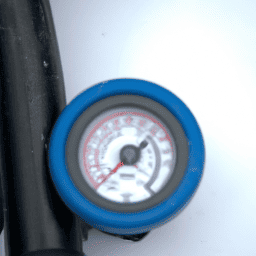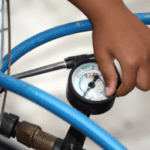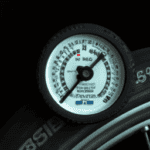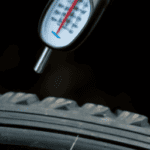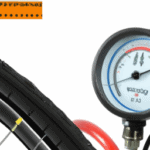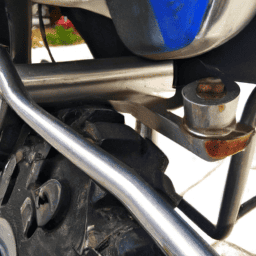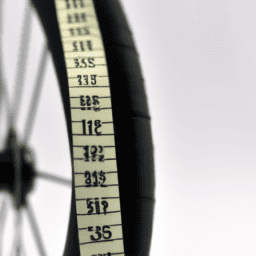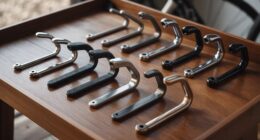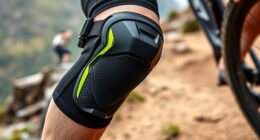Have you ever been on a bicycle ride and felt as though you were laboring just to maintain your normal speed? Do you ever get the sensation that you’re exerting more effort than seems necessary? If that’s the case, it might be that the pressure in your tires isn’t right.
Proper tire pressure is crucial for maximizing your bike’s efficiency and performance. Knowing the right amount of air to put in your bicycle tires can be a bit confusing, but it’s an essential part of maintaining your bike’s performance.
Not only does it make your ride smoother and more comfortable, but it also helps prevent flats and prolongs the life of your tires. In this article, we’ll guide you through the process of determining the right amount of air for your bike tires, taking into consideration factors like your riding style and terrain.
So, let’s get started!
Key Takeaways
- Proper tire pressure is crucial for bike efficiency, performance, and safety.
- Recommended tire pressure varies based on valve type, tire material, terrain, rider weight, and tire size.
- Regularly checking tire pressure can prevent flats, improve traction, and reduce wear and tear.
- Digital gauges are the most accurate and easy to read for measuring tire pressure, while stick gauges are the simplest and most affordable option.
Understand the Importance of Proper Tire Pressure
You gotta understand the importance of keepin’ your bicycle tires at the right pressure, buddy. Proper tire pressure is essential for optimal performance and safety of your bike.
Riding with incorrect tire pressure can result in poor handling, reduced traction, and increased risk of punctures. The importance of proper tire pressure also extends to your safety.
Riding with underinflated tires can cause pinch flats or rim damage, while overinflated tires can lead to a blowout. Both scenarios can be dangerous, especially when you’re cruising at high speeds.
So, before you hit the road, make sure your tires are properly inflated to ensure a smooth, safe ride. Now, let’s talk about how to check your tire size and recommended pressure.
Check Your Tire Size and Recommended Pressure
Knowing the right tire size and pressure for your ride is like having a smooth sail on the open sea. It ensures you have a comfortable and safe ride while prolonging the life of your tires.
When checking tire pressure, consider the valve type. Schrader valves are common and similar to car tires, while Presta valves require a special pump. It’s important to have the correct pump to avoid valve damage.
Tire material is also important in determining the recommended pressure. Different materials require different pressures. For example, a thinner tire may require higher pressure than a thicker tire. The recommended pressure may vary based on the terrain you’ll be riding on. A smooth road may require lower pressure than rougher terrain.
Consider all of these factors when determining the recommended pressure for your tires. This ensures a comfortable and safe ride. Moving on to the next section, consider your riding style and terrain.
Consider Your Riding Style and Terrain
When considering your riding style and terrain, it’s important to understand the differences in needs and requirements between road biking, mountain biking, and commuting.
Road biking typically involves smooth, paved surfaces and requires high pressure, narrow tires for speed and efficiency.
Mountain biking, on the other hand, requires wider, lower pressure tires for better traction and shock absorption on rough terrain.
Commuting may involve a mix of surfaces and conditions, but generally requires a balance between speed, comfort, and durability.
By understanding these differences, you can choose the right tires and pressure to optimize your riding experience.
Road Biking
If you’re looking to hit the road on your bike, make sure to check the recommended tire pressure for your specific model and adjust accordingly. Road biking involves high speeds on paved surfaces, so having the right amount of air in your tires is crucial for optimal performance and safety. A general rule of thumb is to inflate your tires to the maximum recommended pressure listed on the sidewall of the tire. However, this may not be the best option for everyone.
Consider your weight and riding style when determining the appropriate tire pressure for road biking. A lighter rider may need less pressure, while a heavier rider may need more. Additionally, if you prefer a more comfortable ride, you may want to slightly decrease the pressure. Below is a table outlining recommended tire pressures for road biking based on rider weight and tire size:
| Rider Weight (lbs) | 700x23c Tire Pressure (psi) | 700x25c Tire Pressure (psi) |
|---|---|---|
| <100 | 90-100 | 85-95 |
| 100-125 | 100-110 | 95-105 |
| 125-150 | 110-120 | 105-115 |
| 150-175 | 120-130 | 115-125 |
| >175 | 130-140 | 125-135 |
Now, if you’re more of an off-road rider and enjoy the thrill of mountain biking, there are some different factors to consider when it comes to tire pressure.
Mountain Biking
So you’ve decided to hit the trails on your trusty mountain bike, huh? Well, let me tell you, finding the perfect tire pressure is crucial for a smooth and safe ride. Trail features like rocks, roots, and drops can cause your tires to lose traction and even puncture if they’re not properly inflated.
To avoid this, start with a tire pressure of around 30-35 psi, and adjust accordingly based on the trail conditions and your personal preferences. When it comes to mountain biking, having the right gear can make all the difference.
In addition to finding the perfect tire pressure, it’s important to invest in quality tires with good grip and a durable build. You’ll also want to make sure your bike has proper suspension and brakes to handle the rough terrain. Don’t forget to wear a helmet and other protective gear to keep yourself safe on the trails.
With the right combination of gear and tire pressure, you’ll be ready to tackle any mountain biking adventure with confidence. As you transition into the next section about commuting, remember that while mountain biking requires a different approach to tire pressure and gear than road biking, both activities share the importance of proper maintenance and safety measures.
Commuting
Getting to work or school by bike can be a convenient and eco-friendly option for commuters. Aside from avoiding traffic jams and helping reduce emissions, there are also health benefits associated with cycling. Regular exercise strengthens the muscles, improves blood circulation, and boosts energy levels, all of which can lead to increased productivity and a generally happier mood.
Moreover, cycling can save you money on gas and car maintenance, and it’s a great way to explore your city and discover new neighborhoods. To make your commute as smooth and safe as possible, you need to plan your route carefully. Look for bike-friendly roads, bike lanes, and dedicated bike paths, and avoid busy streets and high-traffic areas.
You can use online maps or apps to find the best commuting routes, and don’t forget to factor in the weather and the time of day. Always wear appropriate clothing and gear, including a helmet, reflective clothing, and lights, and follow traffic laws and signals. By taking these steps, you can enjoy the many benefits of commuting by bike while staying safe and comfortable.
To ensure that your bike is ready for the road, it’s important to use a tire pressure gauge to check the air pressure in your tires regularly. This will help prevent flats, improve traction, and reduce wear and tear on your tires.
Use a Tire Pressure Gauge
To accurately measure the air in your bicycle tires, use a tire pressure gauge and press it onto the valve stem. There are various types of gauges available in the market, including digital, analog, and stick gauges. Digital gauges are the most accurate and easy to read, while analog gauges can be a bit tricky to read due to parallax error. Stick gauges are the simplest and most affordable option, but they are not as precise as digital or analog gauges.
If you don’t have a tire pressure gauge, there are alternatives to gauges, such as pressing the tire with your fingers or checking the tire’s firmness by bouncing it on the ground. However, these methods are not as reliable as using a gauge.
It’s crucial to check your tire pressure regularly because underinflated or overinflated tires can affect your bike’s performance and safety. Adjust your tire pressure as needed to ensure a smooth and comfortable ride.
Now that you know how to measure your tire pressure accurately, let’s move on to adjusting your tire pressure as needed.
Adjust Your Tire Pressure as Needed
When it comes to adjusting your tire pressure, there are a few key points you need to keep in mind. First off, you’ll want to make sure you’re checking your tire pressure on a regular basis. This is especially important if you’re someone who rides your bike frequently or in varying weather conditions.
Additionally, it’s important to be aware of the signs of overinflation and underinflation, so you can adjust your tire pressure as needed. Finally, make sure you’re inflating your tires properly by following some simple tips and techniques for optimal performance.
How Often to Check Tire Pressure
Make sure you check your tire pressure regularly to ensure a smooth and safe ride! Frequency check is critical to keeping your tires properly inflated.
It’s recommended to check your tire pressure once a week, especially if you ride your bicycle frequently. This way, you can maintain the optimal pressure level for your tires. Optimal pressure level varies depending on the type of tire and the weight of the rider.
Typically, road bike tires require higher pressure, whereas mountain bike tires require lower pressure. To determine the optimal pressure level for your bike, check the sidewall of the tire for a recommended range. Keep in mind that underinflated tires can cause slow and sluggish riding, while overinflated tires can lead to a bumpy ride and even damage to the tire.
Now that you understand the importance of checking your tire pressure regularly, it’s time to learn about the signs of overinflation and underinflation. By knowing these signs, you can quickly identify any potential issues with your tires before hitting the road.
Signs of Overinflation and Underinflation
Now that you know how often to check your tire pressure, it’s important to understand the signs of overinflation and underinflation. Overinflated tires can lead to a harsh ride, decreased traction, and increased risk of a blowout. On the other hand, underinflated tires can cause poor gas mileage, premature wear, and decreased handling.
To avoid these issues, it’s crucial to regularly check your tire pressure and make adjustments as needed. One factor that can affect tire pressure is temperature. As the temperature drops, so does tire pressure. Conversely, as the temperature rises, tire pressure increases. This means that you may need to adjust your tire pressure more frequently during extreme weather conditions.
To measure tire pressure accurately, use a tire pressure gauge and check the pressure when the tires are cold. This means before you start driving or at least three hours after driving.
Moving forward, to ensure your bike tires are properly inflated, there are a few tips to keep in mind. Proper inflation is not only important for safety but also for optimal performance. So, let’s dive into some tips for proper inflation.
Tips for Proper Inflation
To make sure your ride is smooth and safe, it’s important to keep in mind a few tips for properly inflating your bike tires. One of the most important things to remember is the importance of consistent inflation. This means regularly checking and adjusting the pressure in your tires to make sure they are always at the recommended level. Underinflated tires can cause sluggish handling, while overinflated tires can lead to a harsh ride and increased chance of a blowout.
Another thing to keep in mind is the effects of temperature on tire pressure. As the temperature changes, the pressure in your tires can fluctuate, which can affect your ride quality and safety. For example, in colder temperatures, the pressure in your tires may drop, while in hotter temperatures, the pressure may increase. It’s important to regularly check your tire pressure and adjust it accordingly, especially if you’re planning a ride in extreme temperatures. The table below provides recommended tire pressure levels based on tire size and rider weight, to help ensure a safe and enjoyable ride.
| Tire Size | Rider Weight | PSI |
|---|---|---|
| 700x23c | Up to 150 lbs | 100-120 |
| 700x25c | Up to 165 lbs | 100-120 |
| 700x28c | Up to 180 lbs | 100-120 |
| 700x32c | Up to 200 lbs | 100-120 |
| 26×1.5 | Up to 200 lbs | 35-45 |
Remember, properly inflated tires not only provide a better ride, but also reduce the risk of accidents and prolong the life of your tires. Keep these tips in mind and take the time to regularly check and adjust your tire pressure for a safer, smoother ride.
Frequently Asked Questions
Can I use any tire pressure gauge or does it have to be a specific one for bicycles?
You can use any tire pressure gauge, but consider the pros and cons of digital vs. analog. Digital gauges are more accurate and easier to read, while analog gauges have greater durability. Also, note that tire pressure gauges may be less accurate at high altitudes.
How often should I check my tire pressure?
It is important to regularly check your bicycle tire pressure as underinflated tires can negatively impact performance, causing increased rolling resistance, decreased stability, and increased risk of punctures. Check at least once a week for optimal performance.
Does the type of valve on my tire affect how I check the tire pressure?
Before checking your tire pressure, ensure valve compatibility between your tire and inflation tools. Some valves require specific tools. Make sure to consult your owner’s manual for proper inflation guidelines and use a reliable gauge for accuracy.
Is it okay to slightly exceed the recommended tire pressure for better performance?
Exceeding recommended pressure may provide performance benefits, but it can also pose potential risks. Proper gauge usage and frequency of pressure checks are crucial to ensure safety and optimal performance.
How does temperature affect tire pressure and should I adjust accordingly?
To ensure optimal performance, adjust tire pressure according to terrain and altitude. Temperature also affects tire pressure; as it rises, pressure increases. Conversely, lower temperatures cause pressure to decrease. Adjust accordingly for safe and efficient riding.
Conclusion
Now that you know how much air to put in your bicycle tires, it’s important to understand why proper tire pressure is so crucial.
According to a study by the National Highway Traffic Safety Administration, tires underinflated by just 25% can decrease fuel economy by up to 0.3%. This may not seem like a significant amount, but over time it can add up to a lot of wasted gas and money.
In addition to saving money on gas, proper tire pressure also improves safety and performance. Underinflated tires can lead to poor handling, decreased braking ability, and increased risk of a blowout. On the other hand, overinflated tires can cause a harsh ride, decreased traction, and premature wear.
By regularly checking and adjusting your tire pressure, you can ensure that your bike is performing at its best and you’re getting the most out of your ride. So, take the time to check your tire pressure before each ride and enjoy a smoother, safer, and more efficient biking experience.
